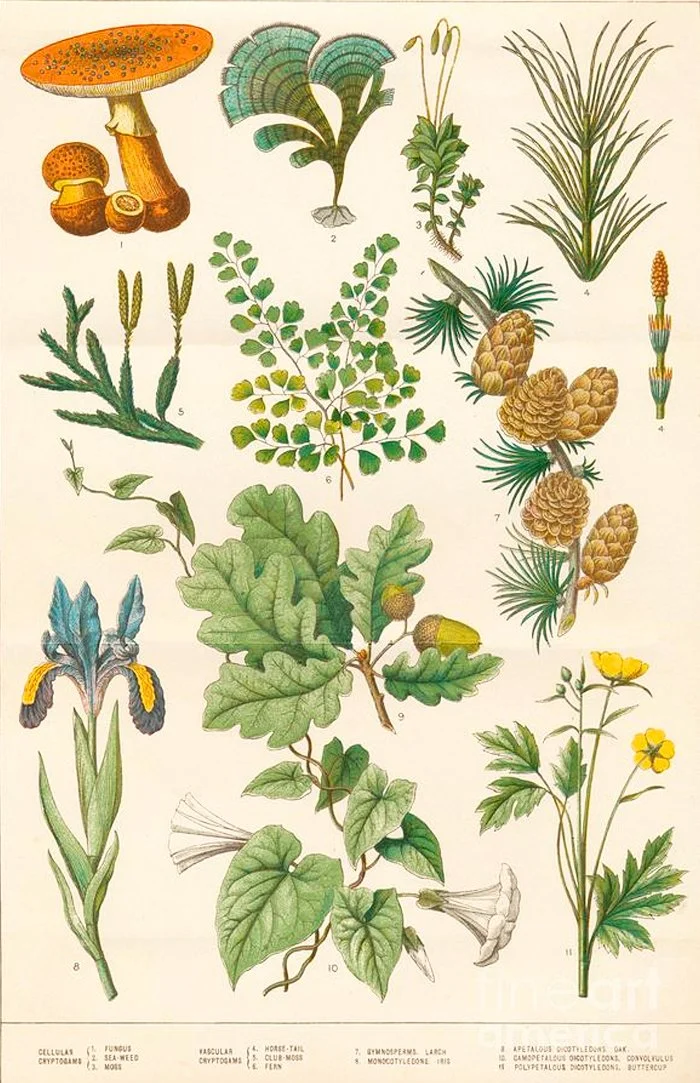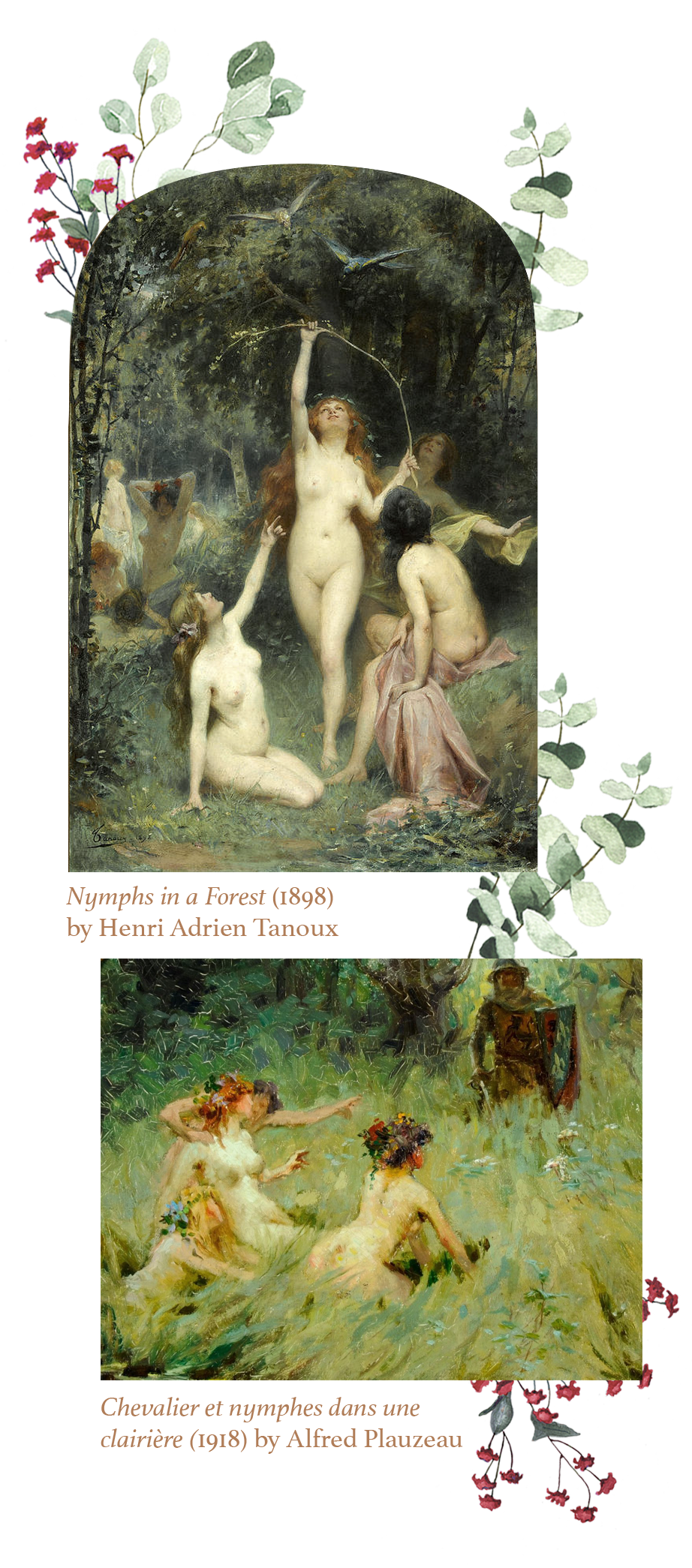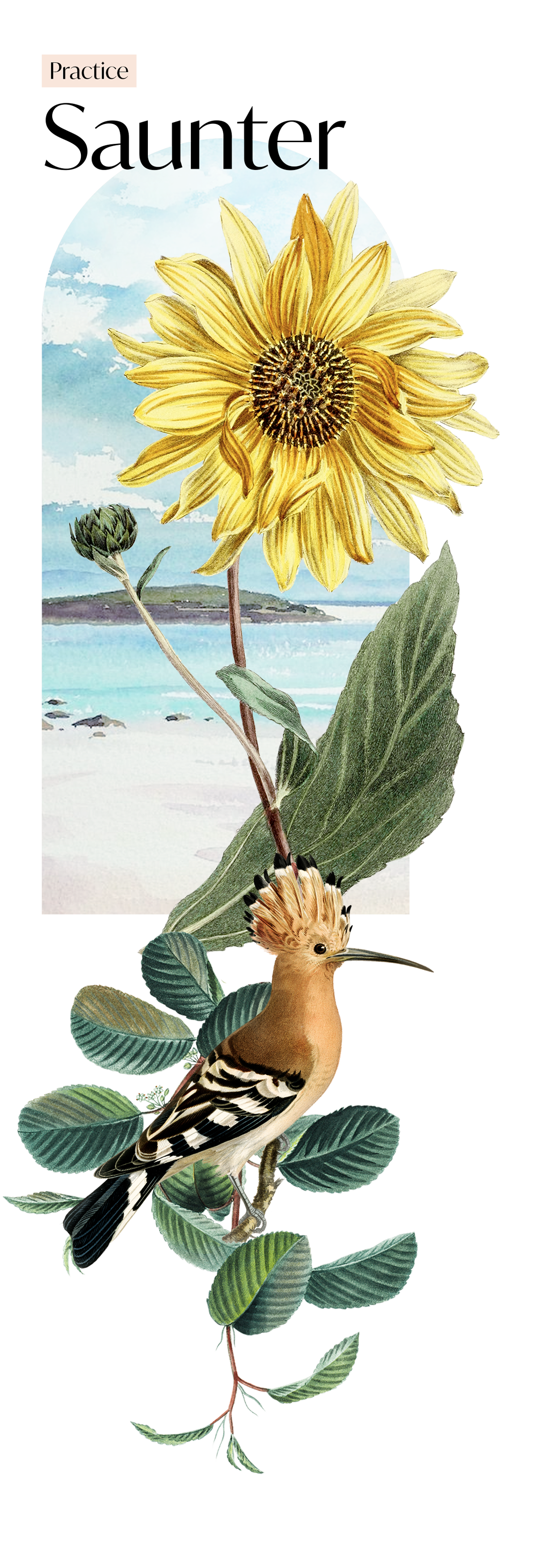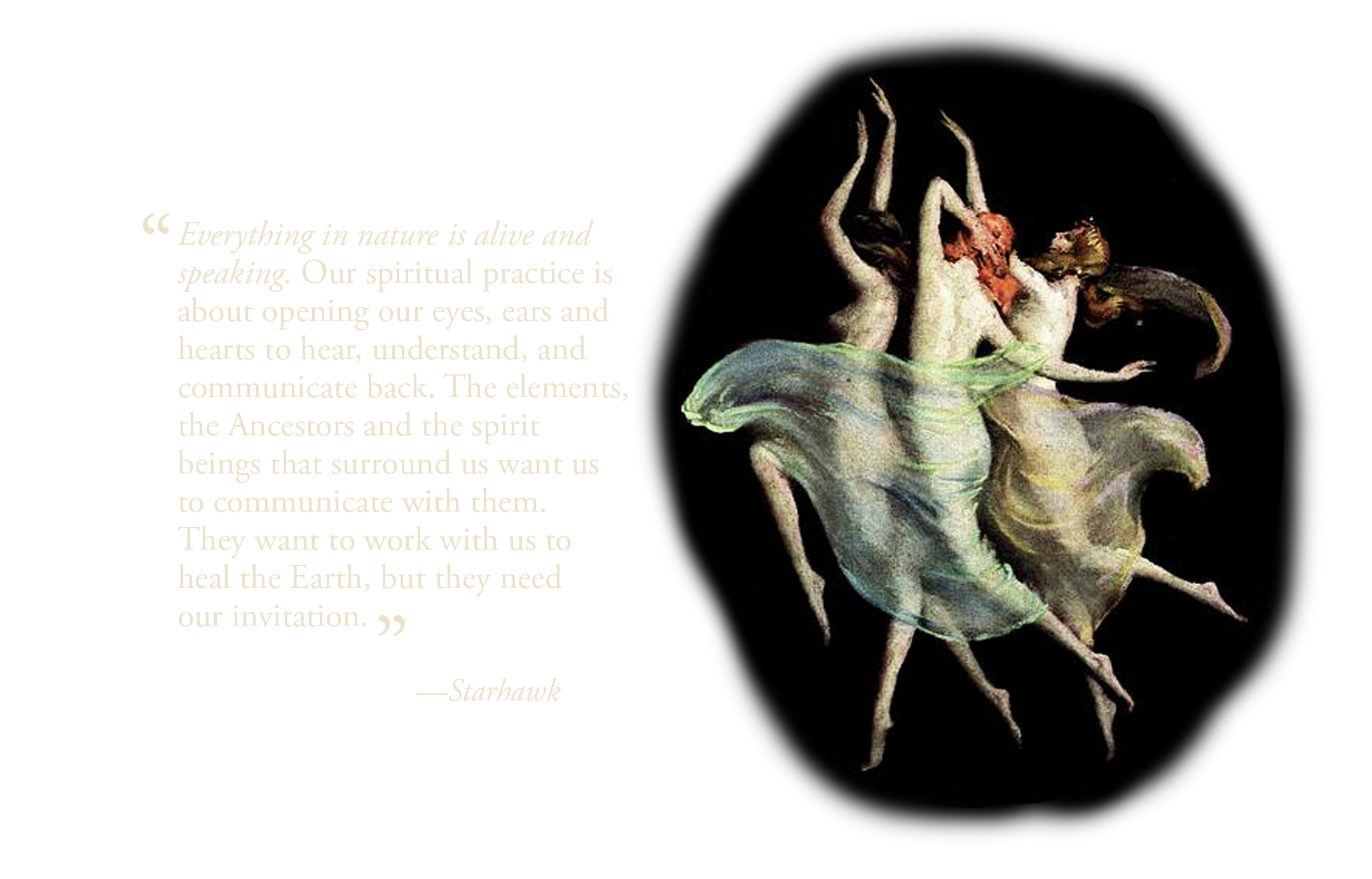
Origin: Ancient Greece.
Commonly associated with: nature, beauty, dancing, Gaia, Artemis.
Sacred places: Oceans, rivers, mountains, forests, meadows, pastures, valleys, caves, lakes, winds, clouds, flowers, springs, fountains.
Abilities: ecological empathy, environmental adaptation, nature unity, zoolingualism, semi-immortality, water and plant mimicry, botanical communication, nature channeling, nature embodiment, self-puppetry, nature guardianship.
*
In Greek mythology, Nymphs were female nature spirits or minor goddesses who lived in and protected forests, groves, and various places in nature. Nymphs were seen to be caregivers of the land and life in general, and were responsible for the care of plants and animals, especially those closely associated with the gods. Nymphs represented aspects of the natural world like bodies of water, islands, trees, or mountains. The Greeks believed that nature was alive and that spirits lived within its elements, so almost everything in nature had a Nymph that inhabited it. Etymologically, the word nymph is related to the Greek word for bride. Humans rarely saw the Nymphs, because they hid from the human world. When seen, Nymphs were described as beautiful, young, graceful maidens, and occasionally wild. In Greek mythology, the Gods were known to be lustful and chase after the Nymphs, so the Nymphs hid from them too. It is said that most Nymphs loved dancing, and waited to be out of the sight of humans to dance.
*
Nymphs are said to have been created from the spilt blood of Ouranos, the God of the skies, that his wife Gaia, the Goddess of the Earth, absorbed. Nymphs were distinguished according to the sphere of nature with which they were connected: Celestial Nymphs are connected to various aspects of sky, including breezes, clouds and stars; Land Nymphs are connected to various landforms, including glens, pastures, valleys and mountains; Underworld Nymphs are servants of Underworld deities; Water Nymphs are connected to bodies of water, from sea to springs, lakes and rivers; and Wood and Plant Nymphs are connected to particular trees and plants.
*
Because Nymphs were minor goddesses, they had certain abilities such as semi-immortality, and other supernatural abilities that connected them to nature. Some of these abilities include: Ecological empathy—the ability to sense the overall well-being and conditions of one's immediate environment and natural setting stemming from a psychic sensitivity to nature, Nature channeling—the ability to channel nature's energy and manipulate it for a myriad of purposes, Nature Unity—the power to become one with nature, Zoolingualism—the power to talk to animal life forms and understand their reactions, Environmental adaptation—the power to survive and adapt to an environment, Nature empowerment—the power to gain strength from nature, Nature Embodiment—the power to become the embodiment of nature, Water and plant mimicry—the power to transform into or have a physical body made up of water or plants, Self-puppetry—the power to contain and preserve one's soul into a single object which remotely controls the body, and Nature Guardianship—the ability to be a protector and keeper of nature and natural forces.
*
Nymphs were intimately connected with the aspects of nature over which they presided. They were thought to die if the water source they were associated with dried up, or if trees they inhabited were cut down. Their livelihood and life-force was intrinsically tied with the elements of nature.
Not uncommonly, some nymphs shared their names with the places they inhabited—for example, one of these eponymous nymphs is Aegina, the nymph of the island that bears her name.
*
Artemis was the Greek goddess of the hunt, the wilderness, the Moon, nature and wild animals. She was a virgin goddess who was accompanied by Nymphs, called the 'Nymphae Artemisiae'—the Nymphs or Artemis. Because virginity was a very important value for Artemis, her nymphs were expected to follow her vow of chastity. The goddess was known to punish her Nymphs if they lost their virginity by, for example, turning them into wild animals. However, she also loved and protected her Nymphs from unwanted advances from humans and gods.
Artemis and her Nymphs were known to dance across the lands, near rivers and lakes, and roamed freely through the mountains and forests. Dances of maidens representing Dryads (tree nymphs) were especially common in the worship of Artemis in her form as goddess of the trees, a role especially popular in the Peloponnese, in southern Greece.
WATER NYMPHS
The Oceanids were the 3000 daughters of two Titans, the pre-Olympian primordial gods of Greek mythology, Oceanus and Tethys. Oceanus was the personification of the great river which encircled the world, and Tethys was a sea goddess. Both Oceanus and Tethys were the children of Ouranos, God of the skies, and Gaia, Goddess of the Earth. The lifespan of an Oceanid was directly connected to the water source she inhabited—if the water dried up, the Oceanid died.
The Oceanids presided over the sources of earth's fresh-water, from rain-clouds to subterranean springs and fountains. Some of the Oceanids personified divine blessings such as Metis (Wisdom), Klymene (Fame), Plouto (Wealth), Tykhe (Good Fortune), Telesto (Success), and Peitho (Persuasion).
Although they had many different roles, Oceanids were responsible for watching over young children, a role appointment to them by Zeus himself. Sailors also worshipped and honored the sea nymphs extensively, dedicating offerings to them, to ask them for protection from storms and danger before embarking on long sea voyages.
*
A subcategory of the Oceanids, the Naiads were the Nymphs of springs and fountains. The Naiads were unique in that they were often found living much closer to humans than the rest of their kin. The wells and springs that provided water to towns and even great cities had their own nymphs who lived side by side with humans. Another type of Oceanid were the Nephelai, the nymphs of the clouds.
An important group of water nymphs was the Nereids. There were fifty Nereids, daughters of the primordial sea god Nereus and the Oceanid Doris. They were the goddesses of saltwater, which in the Greek world specifically referred to the Mediterranean sea. While the dangers of the sea were represented by terrifying monsters, the Nereids represented everything that was beautiful and optimistic about the sea. They were helpful to sailors and fishermen and were described as the kindest of all the nymphs.
*
Other water nymphs include the Heleionomae—the nymphs of wetlands, the Leimenides—the nymphs of the meadows, and the Limnatides—the nymphs of the lakes.
The ancient Greeks also thought fresh-water was found within the flowers and in the cooling breeze, so these also had nymphs associated with them: the Anthousai were the Flower Nymphs—described as having hair that resembled hyacinth flowers, and the Aurai were the subtle, gentle winged-nymphs of the breezes.
Because the Greeks believed all the waters of the world were connected, there were sometimes overlaps between the different types of water nymphs. An Oceanid could travel to an inland well or a Naiad could navigate to an isolated island.
*
LAND NYMPHS
Land nymphs presided over various landforms, including glens, pastures, valleys and mountains. Some of these nymphs weren’t just part of the land, they were the land itself. The nymphs of the land included the Oreads of the mountains, who had no fear of heights, climbed the highest cliffs and jumped over precipices. There were also the Napaeae of the valleys as well as the secretive Corycides of the caves.
The most famous land nymphs were the Hesperides, the nymphs of evening and golden light of sunsets, also called the “Daughters of the Evening” or “Nymphs of the West”, or the Atlantides after their father, the Titan Atlas. They tended a blissful garden in a far western corner of the world, near the Atlas mountains in North Africa at the edge of Oceanus, the world-ocean.
Other types of Land Nymphs included the Alseides, the nymphs of the glens and groves, the Auloniades, the nymphs of pastures and vales, who were closely associated with the rustic gods, particularly Pan, the god of shepherds.
These specific types of land nymphs were not widely mentioned in the works of Greek writers and artists. There aren’t many details about them, and unlike water nymphs, very few land nymphs are named individually in myths.
*
FOREST NYMPHS
Whilst the water nymphs were the most famous of the nymphs of Greek mythology, the Dryads, nymphs of the trees and forests, were also often written about. The Dryads are the Nymphs of the Trees, or nature spirits who live in trees. Dryads were far removed from the human world and said to be shy, except around the goddess Artemis, who was known to be a friend to most nymphs. The Dryads are a famous class of Nymphs because of their relationship with Gaia, The Goddess of Earth and mother of all life. The Goddess was protective of her children, and as goddesses who were connected to nature, the Nymphs had a particularly close bond with her. Dryads were originally Nymphs that had to ask to be turned into trees, specifically from Gaia. In some cases, this transformation was a gift; in others, it was a punishment. Some nymphs found themselves runnings from the advances of lustful gods and men, with little hope of escape, and were turned into trees for their own protection. When Nymphs spread false rumors about gods and goddesses, they were sometimes turned into Dryads as punishment.
*
Every type of tree found in Greece had its own type of Dryad. They made the forests sacred spaces that had to be treated with caution and respect. The nymphs of the ash trees were the Meliae, the nymphs of mountain pines and conifers were the Oreads, the nymphs of oak and poplar trees were the Hamadryads, the nymphs of fruit trees were the Meliades, the nymphs of laurel trees were the Daphnaei, and the nymphs of grapevine trees were the Ampeloi. The Hamadryads were the most popular because oak and poplar trees were prevalent in Greece, these nymphs were thus often found close to humans and on the edge of rivers. A Hamadryad's life was uniquely bound to the individual tree, unlike the other types of tree Nymphs. Because of this unique bond, oak and poplar trees were highly sacred trees, and the gods inflicted harsh punishment on those who cut them down, as this would kill the sacred spirit that lived within. The Hamadryads themselves were extremely grateful to those who protected them from this danger.
*
Although the Dryads were regarded as lesser goddesses and their powers were limited, the Greeks believed that these beings were actually very powerful in their own way, because they were able to inspire strong emotions in humans. The awe that people felt when they looked at Nature was not, to the Greeks, a product of the human mind itself. The peace that came from sitting beneath a tree on a pleasant afternoon and even the terror felt in a dark forest at night were also regarded as extraordinary emotions. Everywhere the Dryads and their fellow Nymphs existed, they were able to touch humans with the gift of sublime emotion. While the Dryads could not wield great weapons or perform amazing feats of magic and strength, they touched the lives of the Greek people in a very important way.
*
Within world mythology, we can find a myriad of environmental themes and lessons in the stories surrounding mythical creatures. We often look to the future for solutions for the climate crisis, searching for new knowledge, new science, new innovations and technologies, and we tend to disregard the wisdom held in our past, in the stories of ancient cultures and civilizations, that can extend our imagination in expansive ways and provide hope and inspiration for the ecological challenges of our time.
Storytelling is an incredibly powerful tool that shapes human culture and influences the way we relate to each other and the world. Stories can transport us to other worlds, where our creativity is enhanced and new visions for the future can be explored. Examining the stories of past cultures can help us uncover the deep wisdom hidden within them, and potentially find new creative solutions to our current dilemmas.
*
The stories of the Nymphs are deeply rooted in ecological thinking and environmental preservation. They enlighten us on the sacred ways people related with nature, and the profound reverence with which they treated the planet and all its different elements. How might we revive the stories of the Nymphs in our modern world, to help shape new ways of being and relating to nature? How might the revival of mythologies help restore right relationship of humans with nature? What can the stories of the Nymphs teach us about relating to the forests, the oceans, the mountains? What place can mythology hold in the ecological movement? Can spiritual ecology integrate ancient mythological themes to create new stories and visions for the future?
How might the Nymphs' abilities inspire us? How might we develop ecological empathy, environmental adaptation, nature empowerment, and nature guardianship? How can biomimicry be weaved into our culture, and become an integral principle in the design of our social, political and economic systems? How might we cultivate awareness of the fundamental interdependence of people and planet?
*
*
Here, you will find simple earth-based and nature-oriented practices, prompts and rituals inspired by the Nymphs, that will help you connect with Nature.
*
*
A powerful way of learning about the elements is to merge with each one individually. To do this you must enter a deep meditative state—for you want to lose yourself and become one with element you are merging with. This is an allowing process; you cannot do it with your mind, you must sink into the experience.
As water, you might become a drop of rain, or a tear running down a face, or you might become the ocean itself, or a drop from a river going down a waterfall, or you might become fine mist bringing life to plants, or a dew drop on a leaf, or a snowflake.
As air, you might become the mighty wind, or you might be the quiet stillness of the air on a perfect summer day, or you might be a gentle breeze moving through the grass or trees, or the great gusts surfing through the landscape.
As earth, you might be a grain of sand that drifts through eternity, or a plot of earth being fed nutrients from the other elements. You might become the earth of a desert, a tropical island, or a rain forest.
As fire, you might become a raging fire, or the small bright flame of a birthday candle, or a flame of a candle burning at a romantic dinner, or the fire in a volcano, or the fire of a beautiful sunrise or sunset.
Do this exercise over time. Don't attempt to merge with all the elements in one day. You will not have the time to process the material and receive the learning you need. You might choose to work with one element for a month or in one particular season.
Spiritual Practice by Sandra Ingerman, in Medicine for the Earth
*
*
To saunter is to walk slowly with reverence for the Earth, to muse and be in reverie in nature. In earlier times, and still in a few places in the world, people have listened to the unconscious via oracles, divination, and the voices of nature. Birds, trees, and even stones have been perceived as valuable sources for the whisperings of the divine. Modern people have a bias that only the human mind and its thoughts have validity, but we too yearn to be touched by something beyond the confines of the “I”.
The origin of the phrase “to saunter” is good medicine for modern people caught in the too-muchness of life. In the middle ages, people used to go on pilgrimages to the Holy Land, and when people in the villages through which they passed asked where they were going, they would reply ‘A la Sainte Terre’,—‘To the Holy Land’. And so they became known as sainte-terre-ers or saunterers—those who walk on the earth with reverence for its holiness. Perhaps there was an intuition even in those early times that we would need a way of walking with reverence to recall us from hurried lives.
Go for a walk in nature and receive the blessings of an ancient tree, listen for a message in the song of a bird, take counsel with a resilient stream. Allow yourself to reconnect to the creative matrix that supports all life.
Spiritual practice by Jerry M. Ruhl, Robert A. Johnson in Contentment
*
*
“Go to the oak tree and ask for its story. Go to the river and ask for its story. Go to the goldenrod and ask without saying anything. Ask with your nose, your belly, your eyes. The answer won’t always be words. Won’t always be sound. Sometimes it will be a feeling in your body. Sometimes it will be a smell. Stories don’t belong to human beings. But human beings belong to stories. Let’s enter back into the complex, tangled work of letting go of authorship and letting ourselves be told.”
by Sophie Strand, from her essay ‘Myco Eco Mytho Storytelling’
*
*
This practice is based on a Navajo prayer.
Close your eyes. Breathe out three long, slow exhalations.
See and sense beauty before you. See and sense beauty behind you. See and sense beauty above you. See and sense beauty below you. See and sense beauty all around you.
You can say the words of the Navajo prayer: “I walk with beauty before me. I walk with beauty behind me. I walk with beauty below me. I walk with beauty above me. I walk with beauty around me. My words will be beautiful. In beauty all day long may I walk. Through the returning seasons, may I walk. On the trail marked with pollen may I walk. With dew about my feet, may I walk. With beauty before me may I walk. With beauty behind me may I walk. With beauty below me may I walk. With beauty above me may I walk. With beauty all around me may I walk. In old age wandering on a trail of beauty, lively, may I walk. 30 In old age wandering on a trail of beauty, living again, may I walk. My words will be beautiful”
Breathe out one time. See and feel yourself walking in beauty. How are you feeling? Breathe out again and open your eyes.
*
*
While seated, move your body as if you’re seaweed flowing in the ocean. Fluid but rooted. Watch the surface of your body from the inside. See how the inner surface changes as you move. Repeat as needed to connect to your inner-witness, inner-shapeshifter and your innate fluidity.
Practice by Che Che Luna
*
*
Ground and center. Take a deep breath. Feel your bones, your skeleton, the solidity of your body. Be aware of your flesh, of all that can be touched and felt. Feel the pull of gravity, your own weight, your attraction to the earth that is the body of the Goddess. You are a natural feature, a moving mountain. Merge with all that comes from the Earth: grass, trees, grains, fruit, flowers, animals, metals, precious stones. Return to dust, to compost, to mud.
Meditation from The Spiral Dance, by Starhawk
*

Dive deeper into the world of the Nymphs, the wisdom of trees, biophilia, spiritual ecology, and plant intelligence with these resources including books, articles and films.
-

✎ Book
‘The Hidden Life Of Trees’
by P. Wohlleben -

✎ Book
‘The Forest in Folklore and Mythology’
by Alexander Porteous -

✎ Book
‘Greek Nymphs: Myth, Cult, Lore’
by Jennifer Larson -

✎ Book
‘Spiritual Ecology: The Cry of the Earth’
by Llewellyn Vaughan-Lee (Ed.) -

✎ Book
‘Sacred Ecology’
by Fikret Berkes -

✎ Book
‘Evolutionary Herbalism: Science, Spirituality, and Medicine from the Heart of Nature’
by Sajah Popham -

✎ Book
‘Rooted: Life at the Crossroads of Science, Nature, and Spirit’
by Lyanda Lynn Haupt -

✦ Article
‘Looking to Mythology in a Time of Crisis’
by Hannah Méndez for Atmos -

✎ Book
‘The Secret Teachings of Plants: The Intelligence of the Heart in the Direct Perception of Nature’
by Stephen Harrod Buhner -

✎ Book
‘Finding the Mother Tree: Discovering the Wisdom of the Forest’
by Suzanne Simard -

✎ Book
‘The Sweet Breathing of Plants: Women Writing on the Green World’
by Linda Hogan & Brenda Peterson -

✎ Book
‘Plant Intelligence and the Imaginal Realm: Beyond the Doors of Perception into the Dreaming of Earth’
by Stephen Harrod Buhner -

✎ Book
‘Tree Wisdom: The definitive guidebook to the myth, folklore and healing power of Trees’
by Jacqueline Memory Paterson -

✎ Book
‘Plant Lore and Legend: The Wisdom and Wonder of Plants and Flowers Revealed’
by Ruth Binney -

✻ Illustrated Book
‘The Architecture of Trees’
by Cesare Leonardi & Franca Stagi -

✦ Article
‘The secret life of plants: how they memorise, communicate, problem solve and socialise’
by Amy Fleming -

✎ Book
‘The Spell of the Sensuous: Perception and Language in a More-Than-Human World’
by David Abram -

✷ Documentary
‘Call of the Forest: The Forgotten Wisdom of Trees’
by Jeff McKay -

✎ Book
‘The Nature of Oaks: The Rich Ecology of Our Most Essential Native Trees’
by Douglas W. Tallamy -

✎ Book
‘Dwellings: A Spiritual History of the Living World’
by Linda Hogan -

✎ Book
‘The Lost Art of Reading Nature's Signs’
by Tristan Gooley -

✎ Book
‘Biophilia’
by Edward O. Wilson -

✻ Illustrated Book
‘Folklore and Symbolism of Flowers, Plants and Trees ‘
by Ernst Lehner & Johanna Lehner -

✎ Book
‘The Secret Life of Plants’
by Peter Tompkins & Christopher Bird -

✷ Documentary
‘The Hidden Life of Trees’
by Jörg Adolph -

✷ Documentary
‘Intelligent Trees’
by Julia Dordel -

✎ Book
‘Animal Speak: The Spiritual & Magical Powers of Creatures Great and Small’
by Ted Andrews
Image Credits:
A Wood Nymph (1886), by Robert Pötzelberger • A Water Nymph (1890), by Hans Zatzka • The Oceanids, The Naiads of the Sea (1860), by Gustave Doré • The Oreads (1902), by William-Adolphe Bouguereau • Nymphs Listening to the Songs of Orpheus (1853), by Charles François Jalabert • A Water Nymph (1898), by Léon Jean Basile Perrault • Pearls of the Sea, by Hans Zatzka • Nymphs of the Forest, by Paul-François Quinsac (1858–1929) • Diana and her nymphs after the hunt (1620–1625), by Jan Brueghel the elder & Hendrik van Balen I • Water Nymph, by Hans Zatzka • Diana and her nymphs bathing (c. 1778-82), by Angelica Kauffmann • Diana with her nymphs resting after the hunt (1761), by Pierre Jollain • Nymphs in a Forest (1898), by Henri Adrien Tanoux • Chevalier et nymphes dans une clairière (1918) by Alfred Plauzeau • A Hamadryad (1893), by J.W. Waterhouse • Nyads and Dryads (c. 1880-1900), by Walter Crane • Dance of the Forest Nymphs (1926), by Warren B. Davis • The Wood Nymph (1898), by Charles Marion Russell • A Nymph In The Forest, by Charles-Amable Lenoir • Vanity Fair covers featuring three nymphs, by Warren Davis































